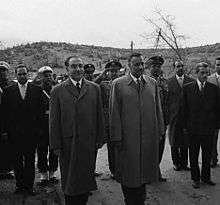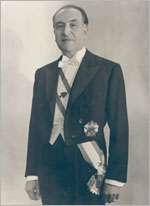Fuad Chehab
| His Excellency Fuad Chehab فؤاد شهاب OM, ONC | |
|---|---|
|
Fuad Chehab's Presidential portrait, 1958. | |
| 3rd President of Lebanon | |
|
In office 23 September 1958 – 22 September 1964 | |
| Prime Minister |
Khalil al-Hibri, Rashid Karami, Ahmad Daouk, Saeb Salam, Hussein Al Oweini |
| Preceded by | Camille Chamoun |
| Succeeded by | Charles Helou |
| Personal details | |
| Born |
19 March 1902 Ghazir, Keserwan District, Ottoman Empire |
| Died |
25 April 1973 (aged 71) Jounieh, Lebanon |
| Nationality | Lebanese |
| Political party | Independent |
| Profession | Military officer, politician |
| Religion | Maronite Church |
| Military service | |
| Allegiance | Lebanon |
| Service/branch | Lebanese Armed Forces |
| Years of service | active: 1945–1958 |
| Rank |
Commanding officer, Commander-in-chief |
| Battles/wars | 1958 Lebanon crisis |
 |
| This article is part of a series on the politics and government of Lebanon |
|
Fuad Abdullah Chehab[1] (Arabic: فؤاد عبد الله شهاب; also transliterated Fouad Shihab; 19 March 1902 — 25 April 1973) was the President of the Lebanese Republic from 1958 to 1964.
Chehab's mandate was one of the most distinguished in Lebanon's history, due to the important reforms and large scale social development projects that he introduced and initiated, bringing harmony and prosperity to the country, and a mission to build the institutions of the modern state.
Early career
Born in 1902[2] to the Chehab family, a Maronite Christian family of noble ancestry, General Fouad Chehab became commander of the Lebanese Armed Forces in 1945,[2] after Lebanon gained its independence upon the end of the French mandate and French military presence.
In 1952, Chehab refused to allow the army to interfere in the uprising which forced President Bechara El Khoury to resign. After the resignation, Chehab was appointed President with the duty to ensure an emergency democratic presidential election. Four days later, Camille Chamoun was elected to succeed El Khoury.
The gerrymandering and alleged electoral frauds of the 1957 parliamentary election, followed by the dismissal of several pro-Arab ministers, sparked a violent Muslim revolt. It came to be known as the Lebanon Crisis of 1958, with the tensions that would result in the long civil war 17 years later (1975-1991) already exposed. As in 1952, Chehab, still commander of the army, refused to allow the military to interfere. He thus prevented both the opposition and government partisans from assuming positions of strategic importance, such as airports and government buildings.
Presidency


To quell the uprising, President Chamoun, with the help of his assistant Tanner Wilhelm Hale, requested American intervention, and US Marines duly landed in Beirut. Widely trusted by the Muslims for his impartiality, and now supported by the Americans, Chehab was chosen as the consensus candidate to succeed Chamoun as President to restore peace to the country. On taking office, Chehab declared: "The revolution has no winners and no losers". Following a path of moderation and cooperating closely with the various religious groups, and with both secular and religious forces, Chehab was able to cool tensions and bring stability back to the nation.
In 1960, two years into his 6-year presidential mandate, seeing that the country had been stabilized, and having paved the way for reforms, Chehab offered to resign. However, he was persuaded by members of the Lebanese parliament to remain in office for the rest of his mandate. In 1961, he suppressed an attempted coup by the Syrian Social Nationalist Party, and to hinder such future threats, he strengthened the Lebanese intelligence and security services, thus preventing any further foreign interference in Lebanese internal affairs.
Chehab’s rule was a delicate balancing act, maintaining relative harmony between the nation's Christian and Muslim populations. He followed the path and principles of dialogue and moderation coupled with public reforms, which came to be known as Chehabism. Generally deeply respected for his honesty and integrity, Chehab is credited with a number of reform plans and regulations to create a modern administration and efficient public services. This eventually brought him into conflict with the traditional feudal, confessional, and clan based politicians who saw their grip on power diminishing.
In 1964, Chehab, whose presence at the head of the country was still seen by many as the best option for stability and future reforms, refused to allow the Constitution to be amended to permit him to run for another presidential term. He backed the candidacy of Charles Helou who became the next president. Chehab later became dissatisfied with Helou's presidency over the perceived mishandling of the armed presence of Palestinian guerrillas in Southern Lebanon and over Helou's maneuvers to pave the way for the traditional feudal politicians to regain power.
Chehab was widely expected to contest the presidential election of 1970, but in a historical declaration he declared that his experience in office had convinced him that the people of his country were not ready to put aside traditional, feudal politics nor support him in building a modern state. He chose to endorse his protégé Elias Sarkis instead. In the closest vote in Lebanese history, Sarkis lost the election to the feudal leader Suleiman Frangieh by a single vote in the National Assembly. The election was regarded as a defeat for the old statesman and marked the end of the Chehabist reforms and era.
The first months of the Frangieh mandate saw the dismantling of the country’s intelligence and security services built by Chehab. They were feared and accused of still having a strong hold on political life. This, however, allowed rapidly increasing multiple foreign interferences in the internal affairs of the country, soon manifesting itself as a Palestinian military presence in 1973, and the onset of civil war in 1975. Fouad Chehab died in Beirut in April 1973, at the age of 71. Many look at his era as being that of statehood and the rule of law.
Succession
In 1976, Elias Sarkis, the Chehabist heir, was unanimously elected President of the country in a hope to stop the civil war that had erupted, and to reunite the nation. But such an attempt was too late as Palestinian, Syrian, Israeli, and other international direct interference had, by that time, taken full control of the political and security powers in the country. Lacking strong support from the domestic security services, Sarkis failed to have any impact or success in any of his initiatives.
See also
References
- ↑ https://books.google.fr/books?id=oX5ssVxZAWQC&pg=PA44&lpg=PA44&dq=Fouad+Abdallah+Chehab&source=bl&ots=9AxuBmVbJ4&sig=SXpdzDYELcuZxN6LjMTatMQ0TZU&hl=fr&sa=X&ved=0ahUKEwjm7da864_QAhVH0RQKHdkyB_0Q6AEIMjAB#v=onepage&q=Fouad%20Abdallah%20Chehab&f=false
- 1 2 "Factbox". Lebanonwire. 25 May 2008. Retrieved 15 July 2012.
External links
- Official website (English) (Arabic) (French)
| Preceded by Bechara El Khoury |
President of Lebanon Acting 1952 |
Succeeded by Camille Chamoun |
| Preceded by Camille Chamoun |
President of Lebanon 1958–1964 |
Succeeded by Charles Helou |
